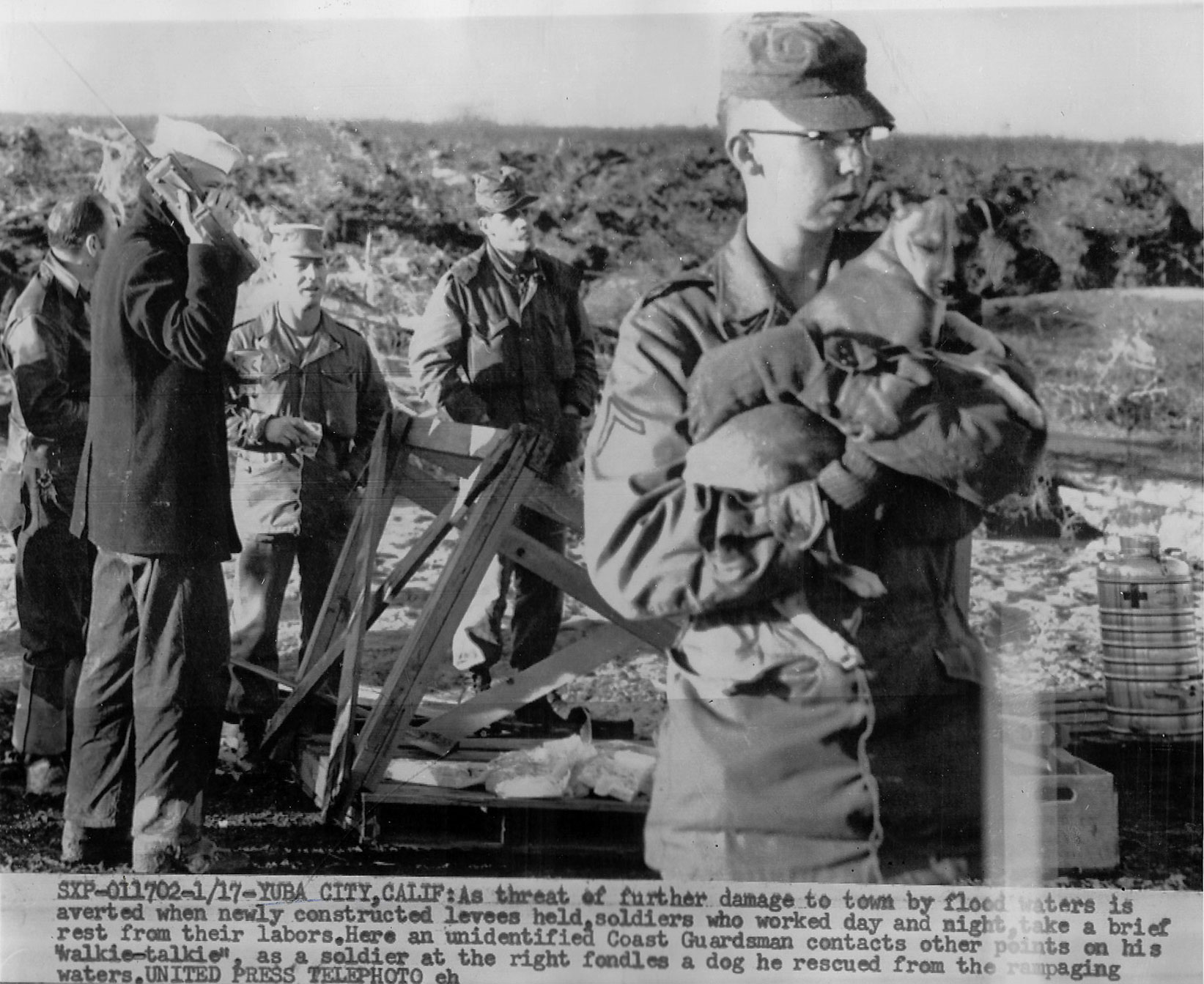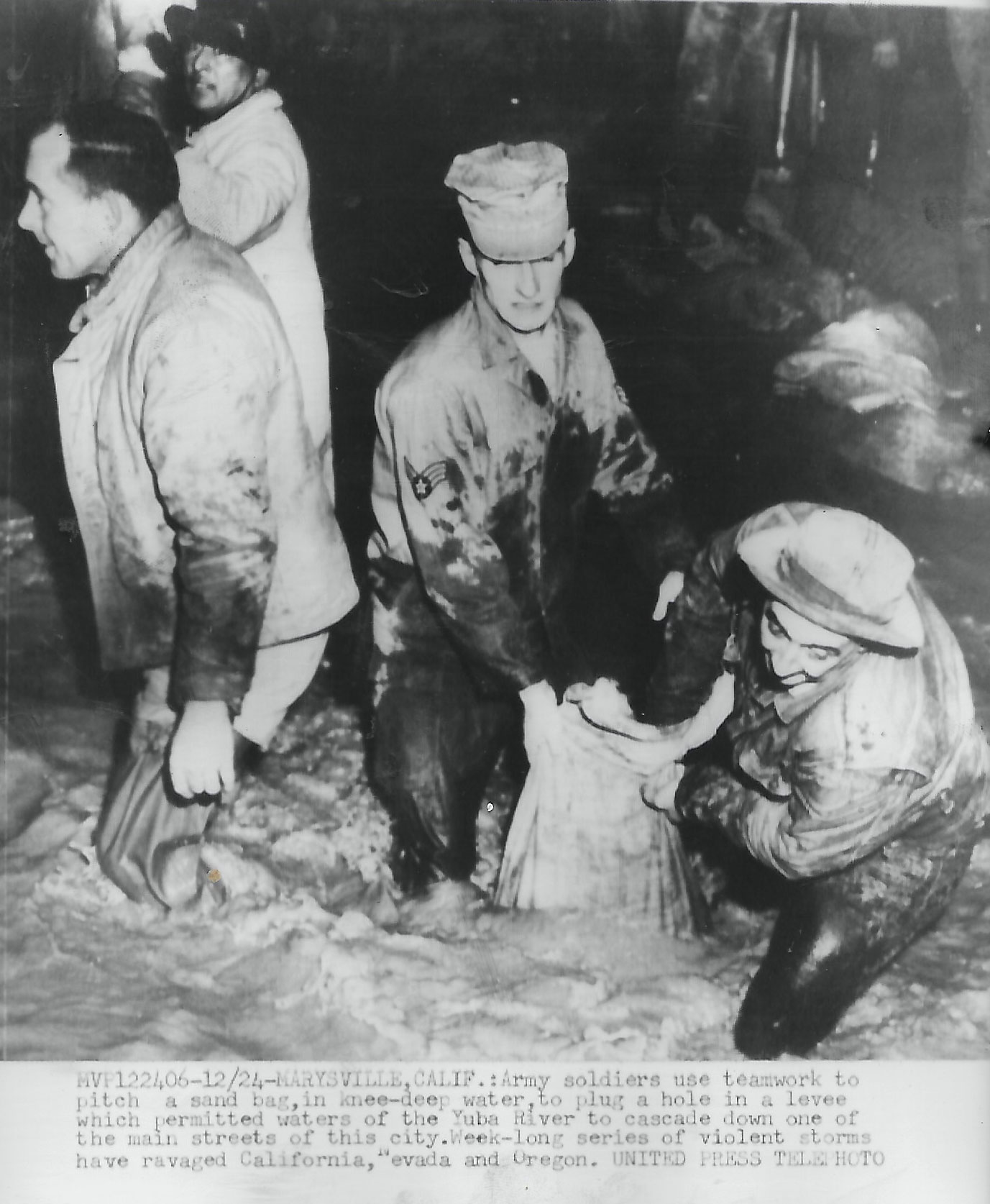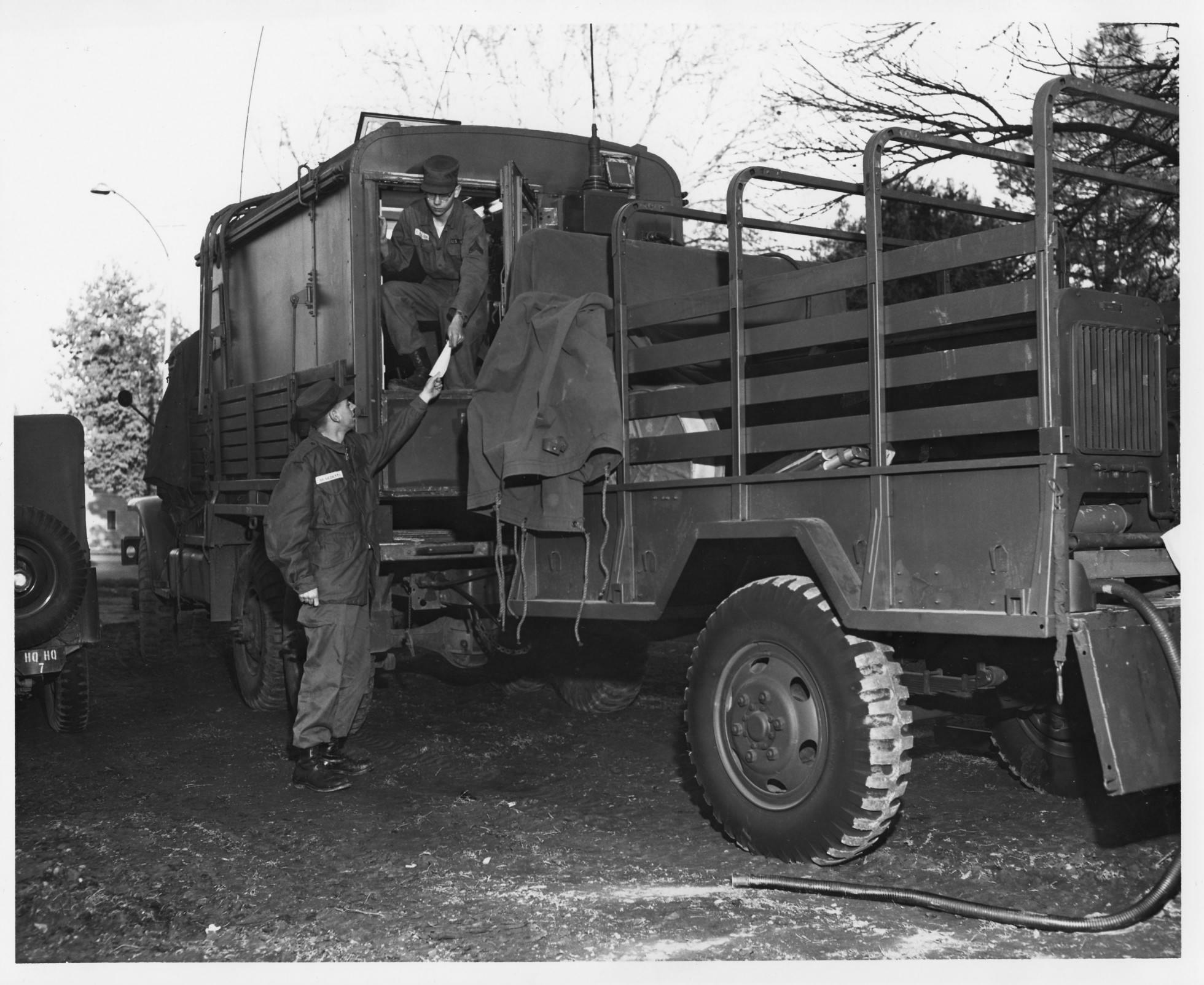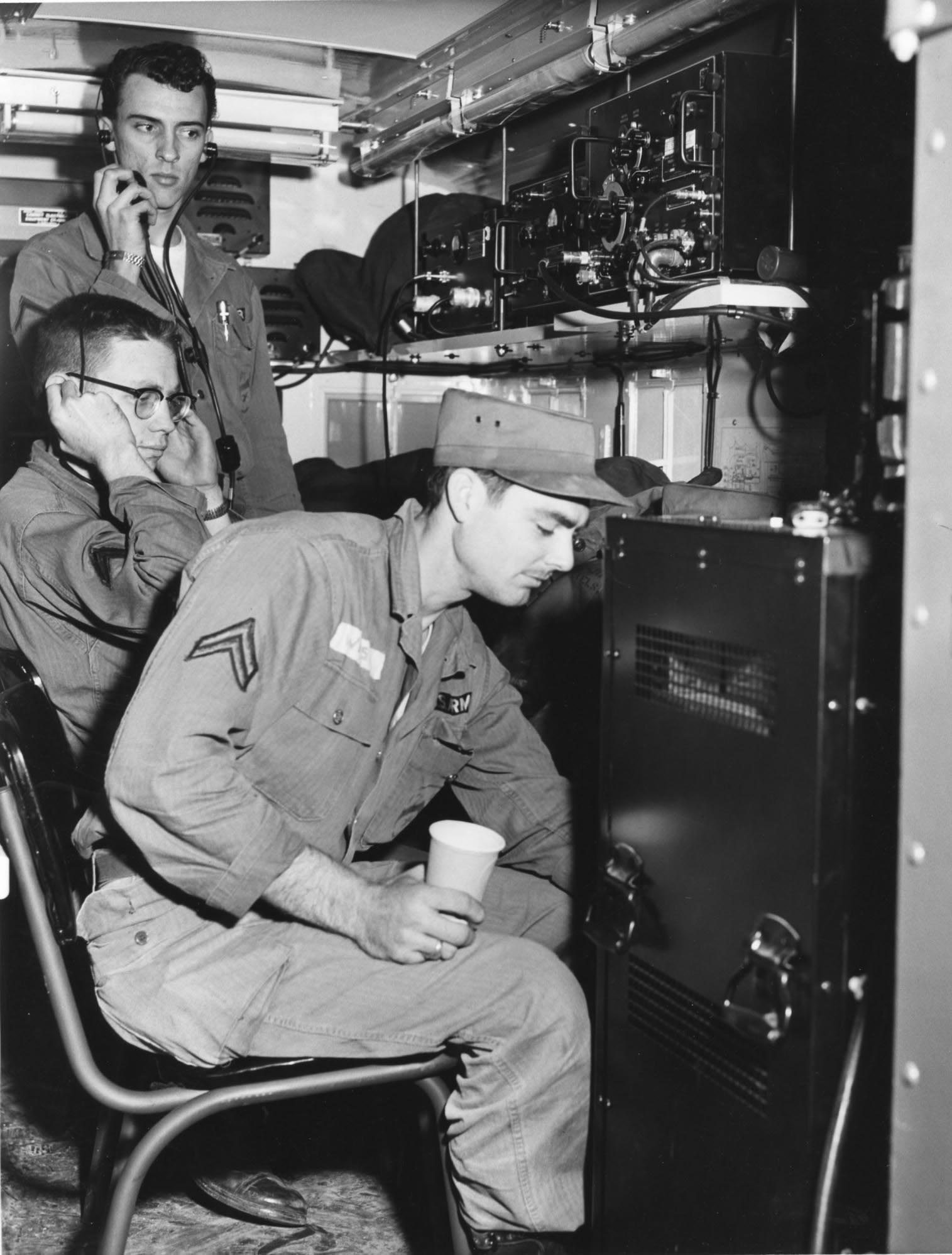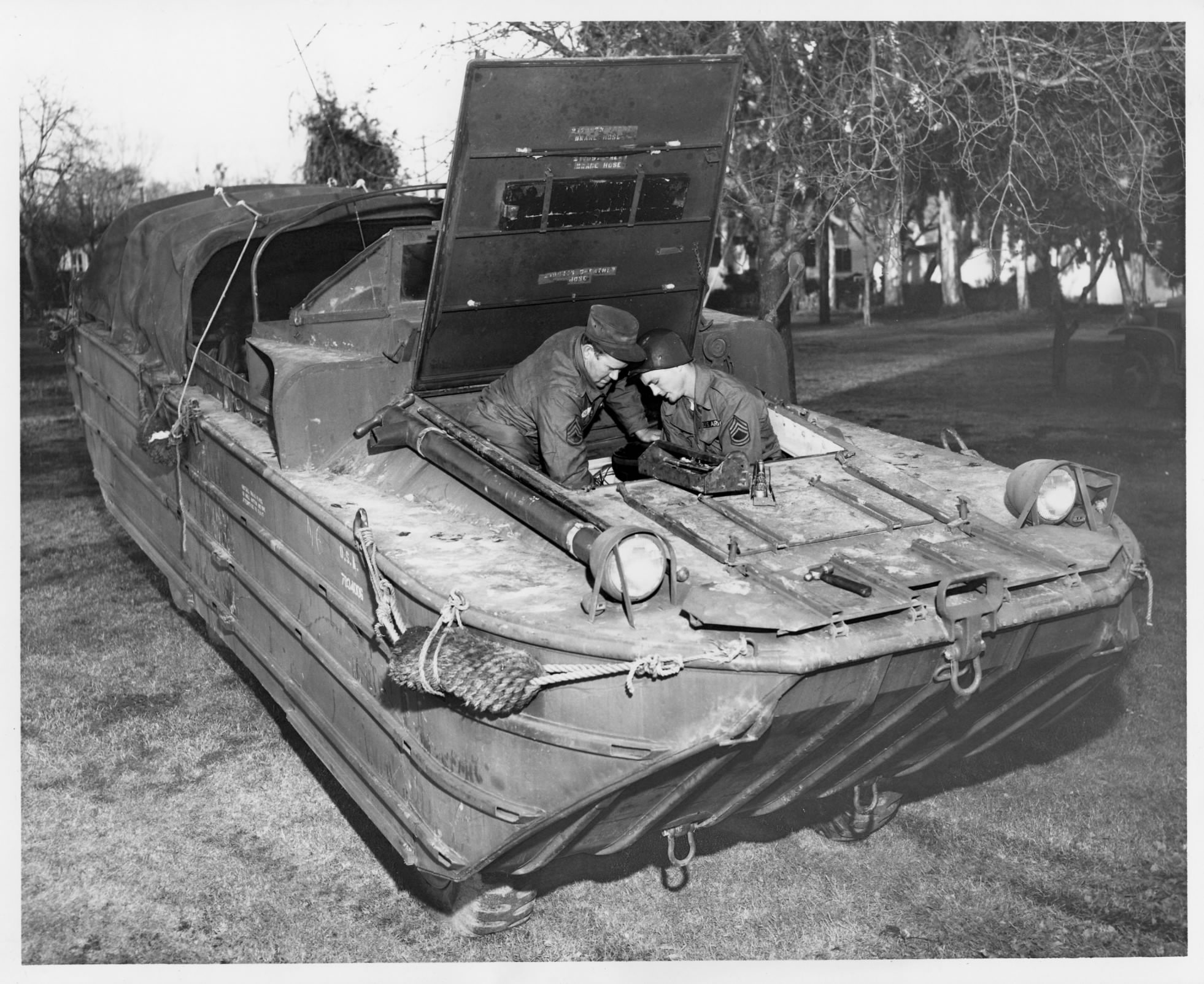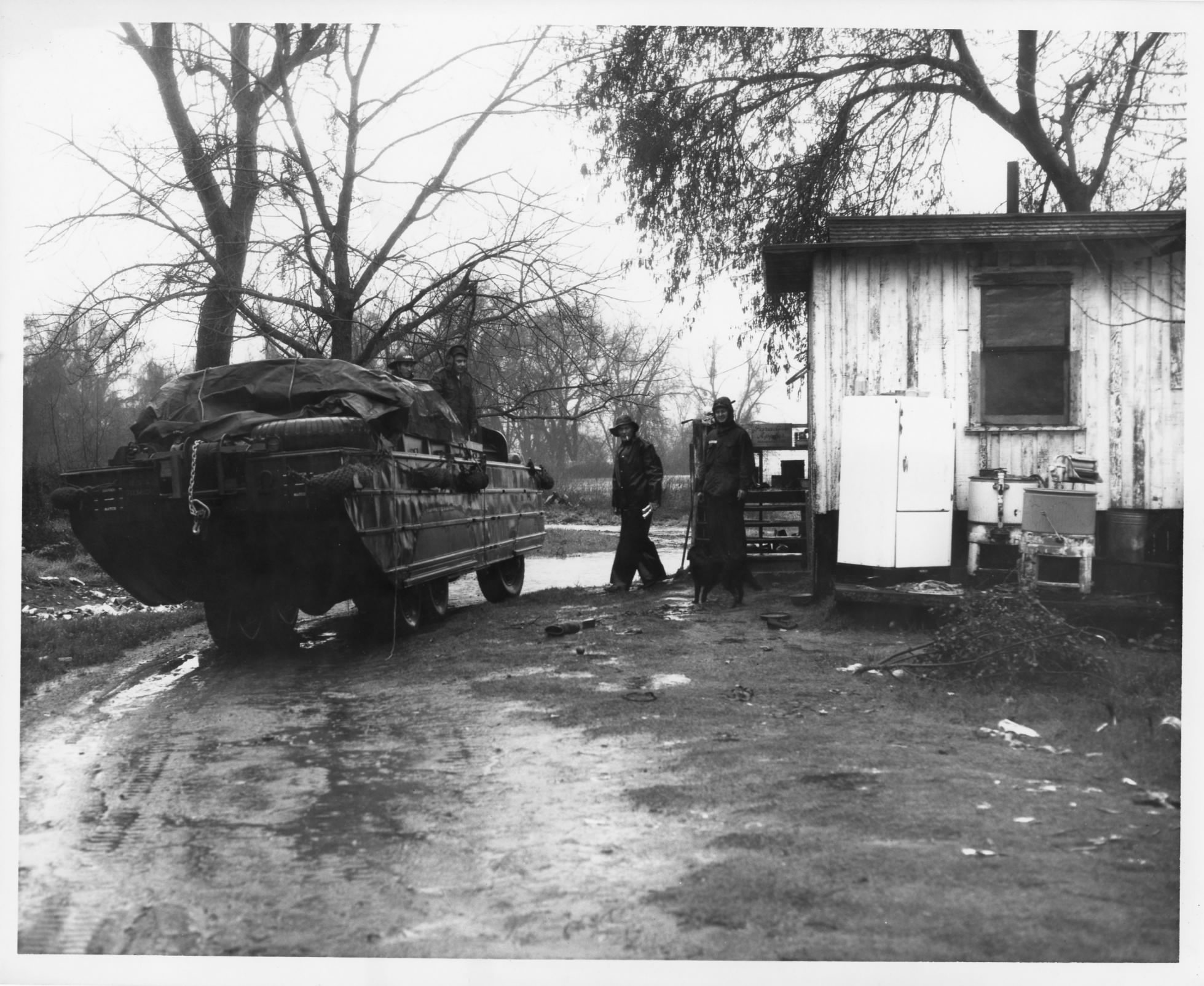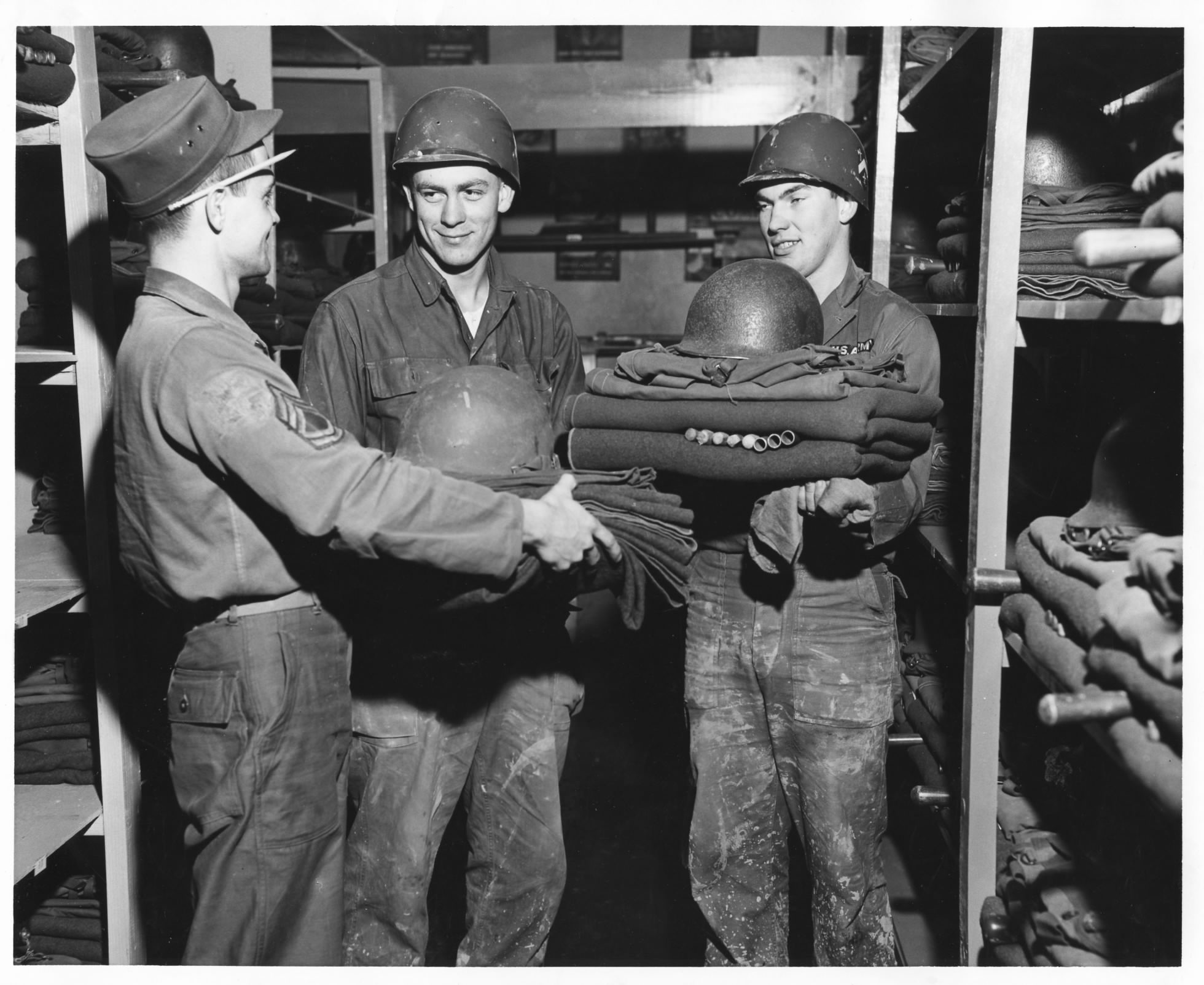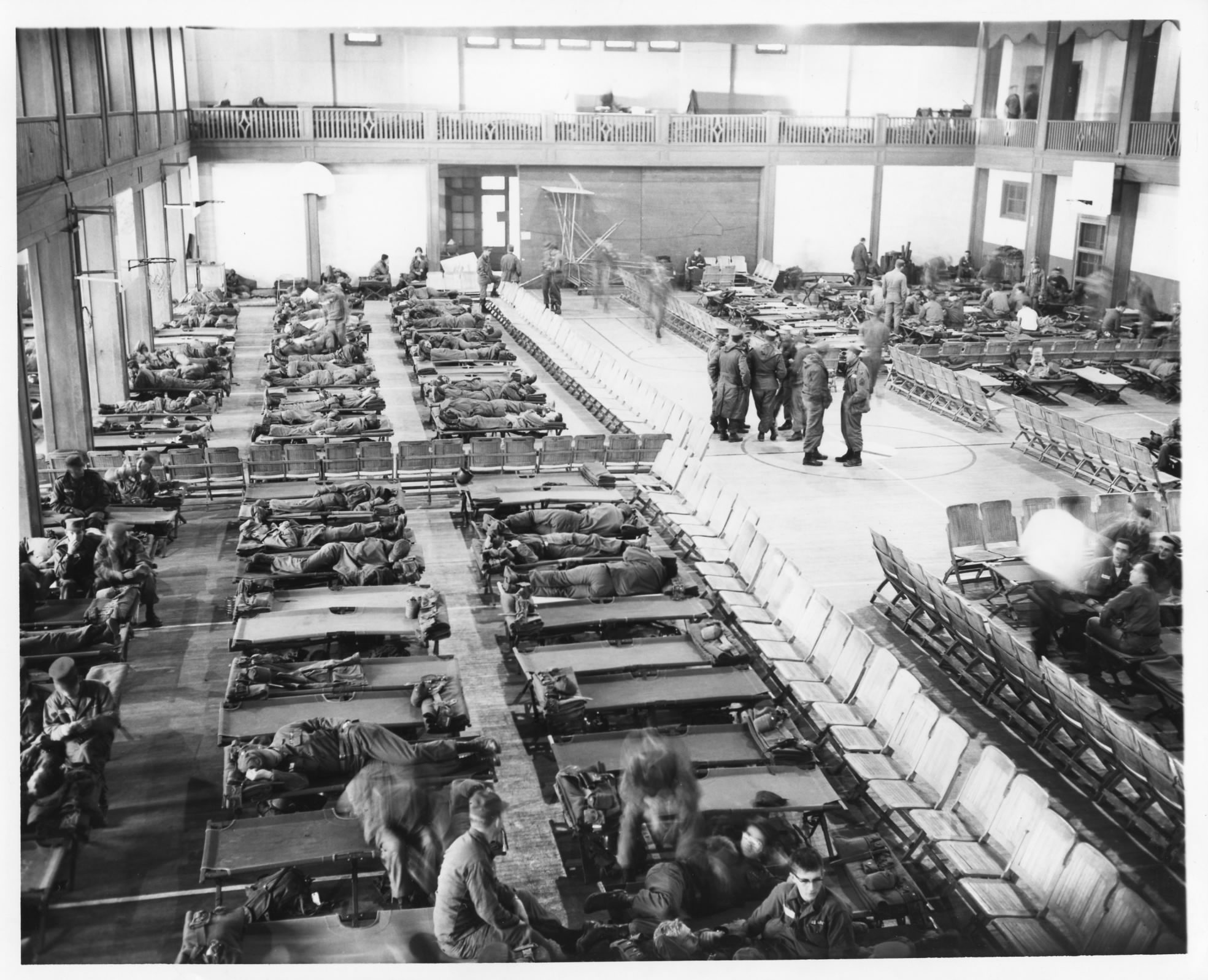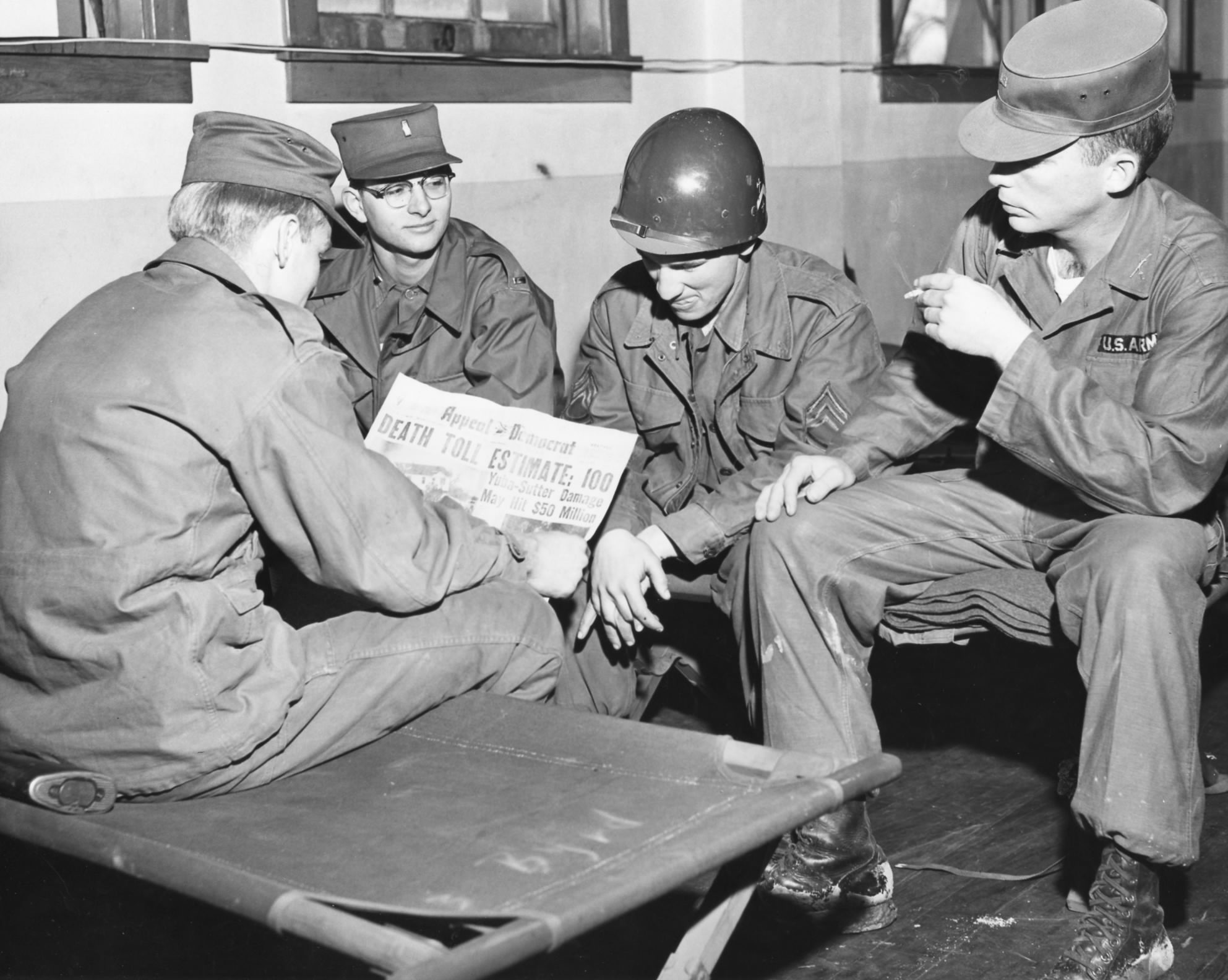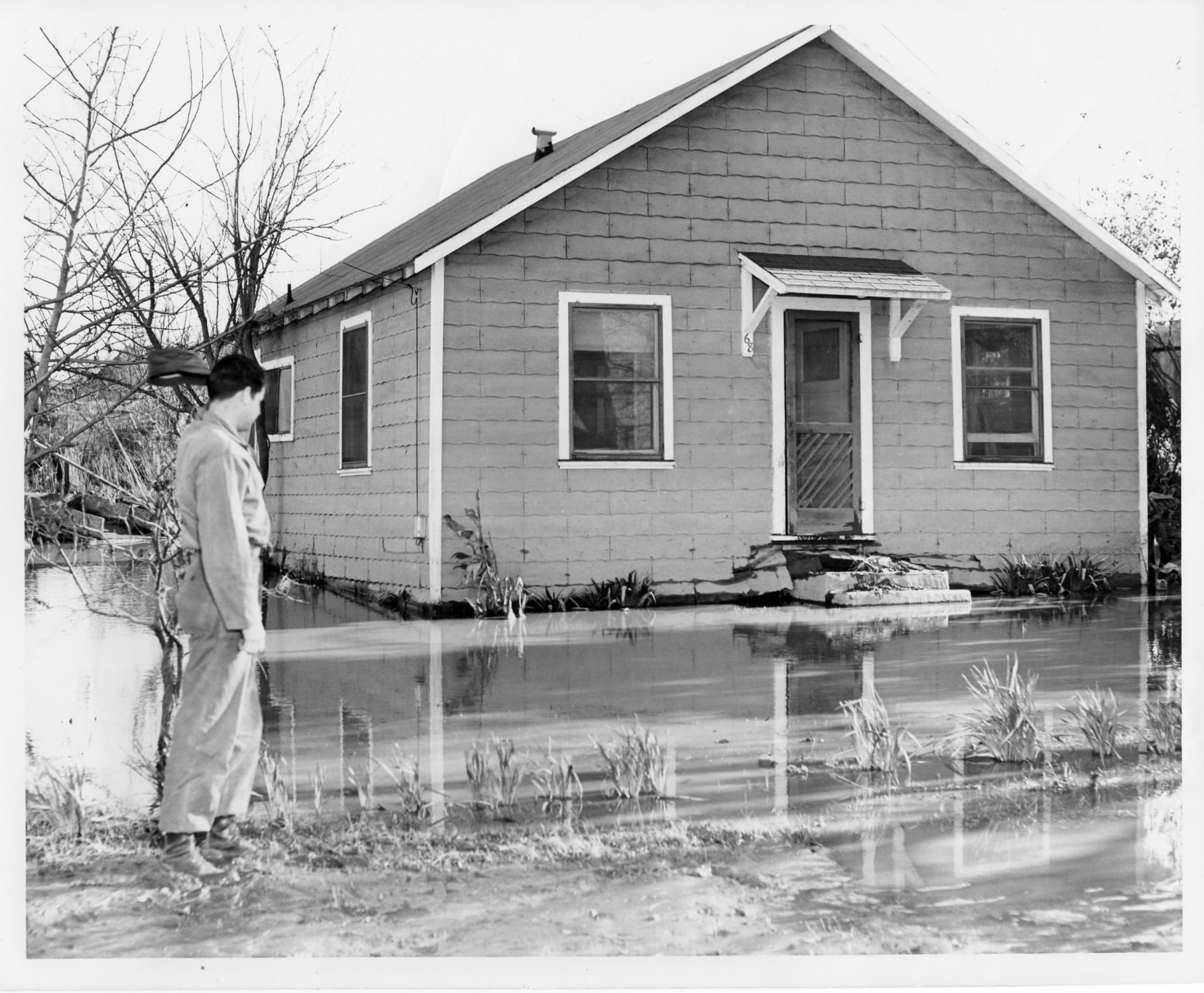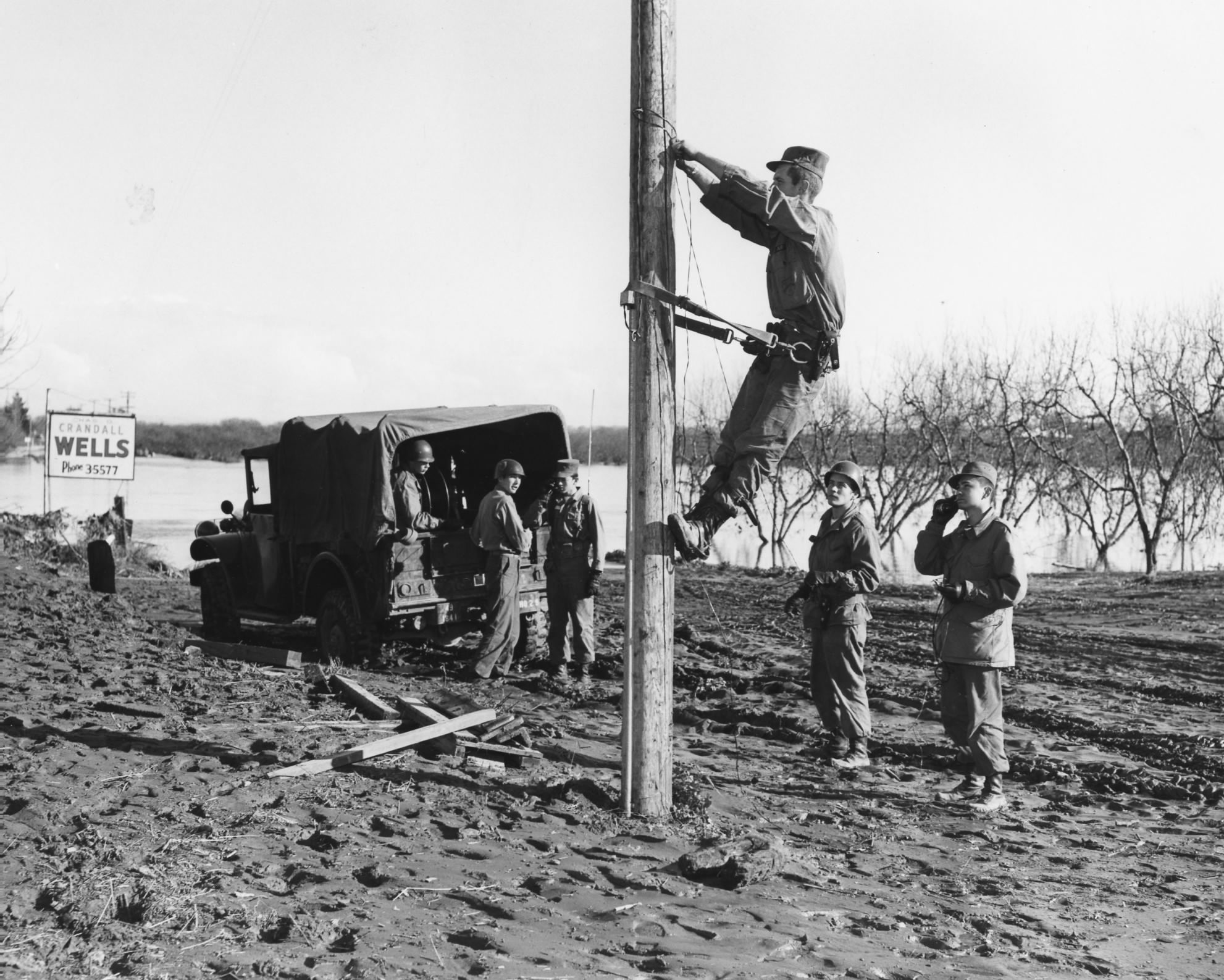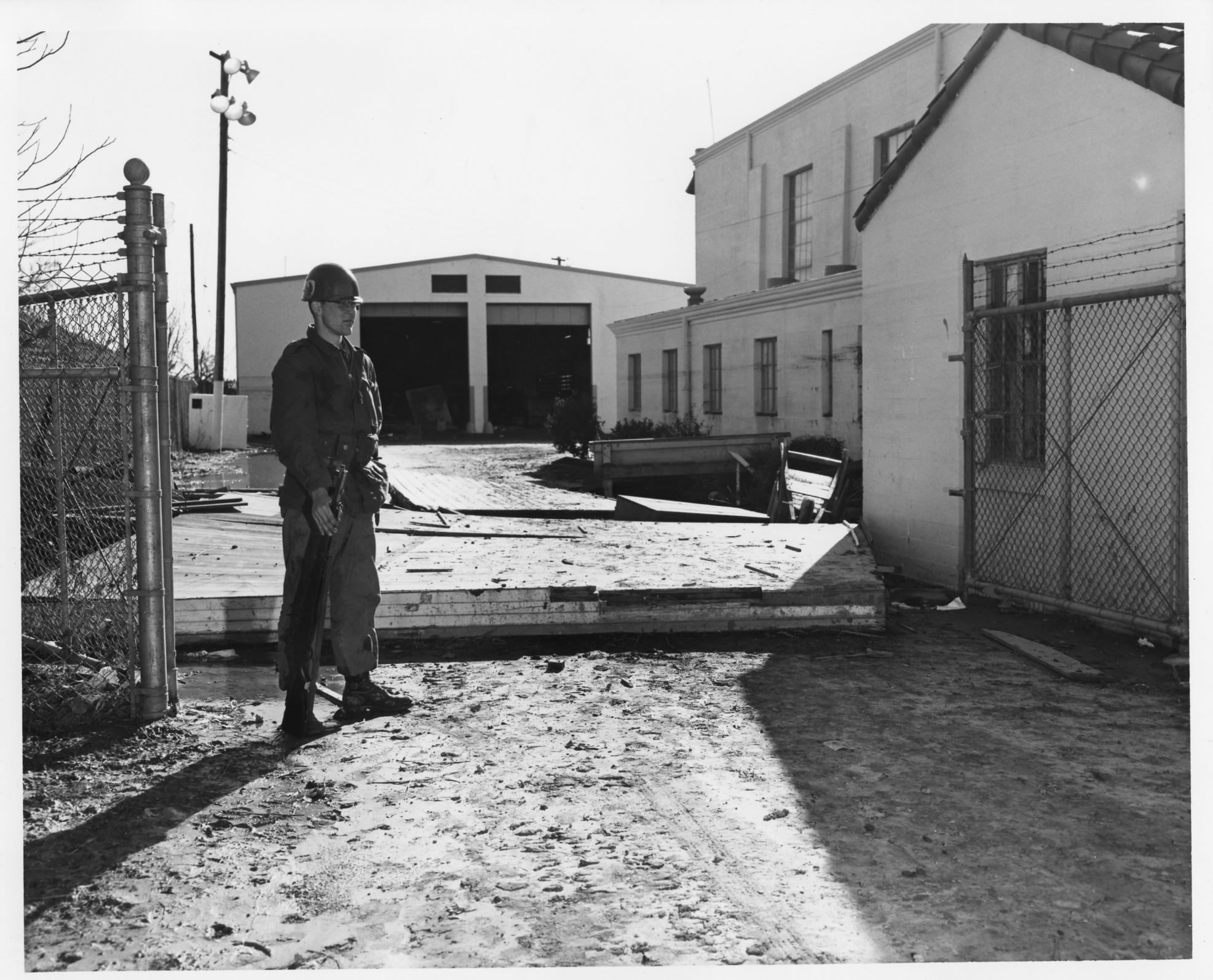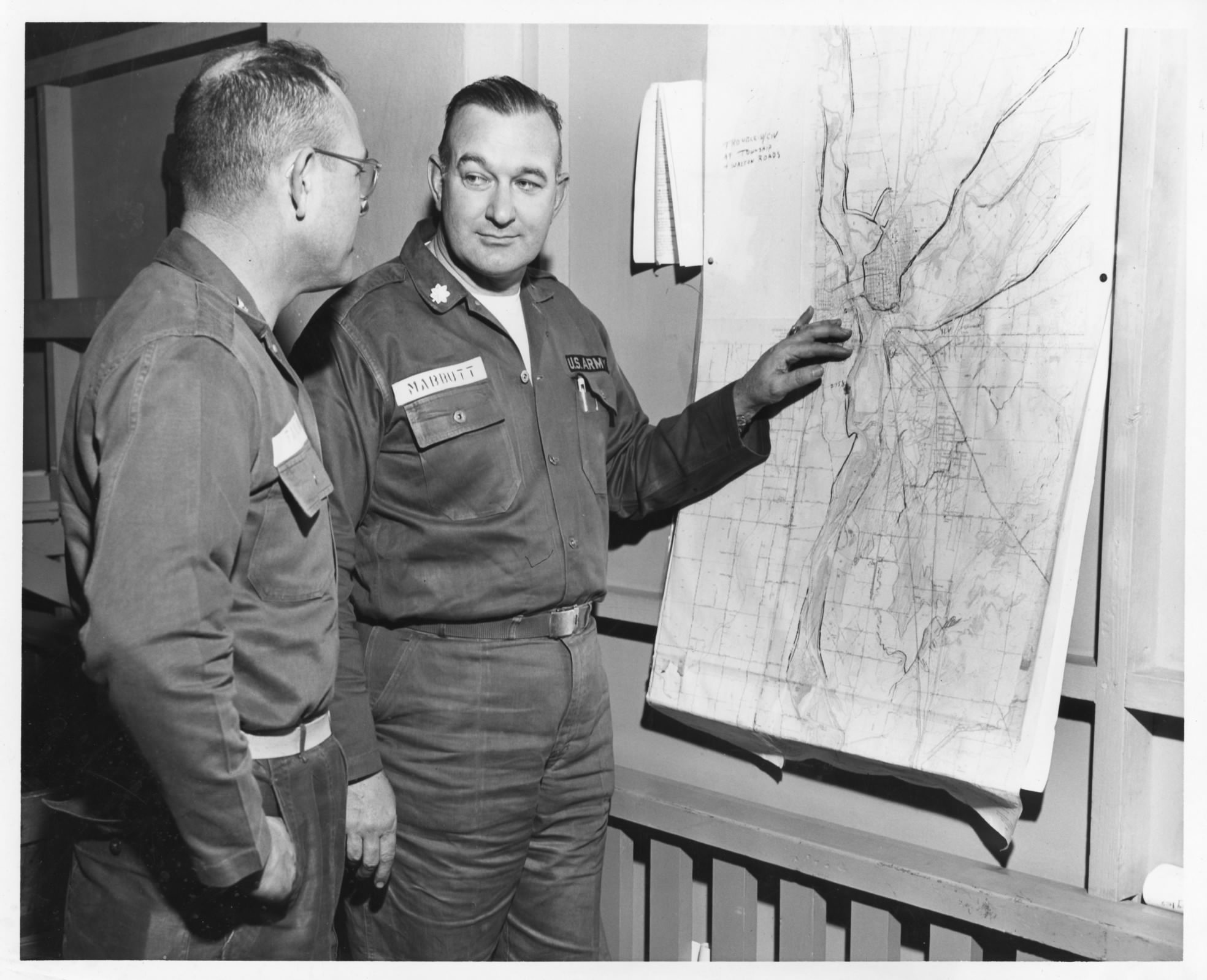
The waters cut a jigsaw puzzle of havoc with virtually every stream and river in Northern, and by week's end, Central California as well, running near the tops of their banks or overflowing. Rain in the high Sierras on top of a six-foot snow pack contributed heavily to the swollen waters. Rain fell from Eureka to Monterey along the coast and through the rich Sacramento and San Joaquin Valleys as far south as Porterville, an airline distance of 450 miles.
This was Northern California by Wednesday evening, December 21st, when the first of countless pleas for assistance from scores of communities began to pour into National Guard headquarters in Sacramento. Hundreds of California National Guardsmen had volunteered their services in the protection of life and property 48 hours before Governor Goodwin J. Knight issued a proclamation Thursday afternoon, December 22nd, declaring Northern California to be in a state of emergency.
Immediately following issuance of the proclamation, state headquarters in Sacramento-already alerted since the evening before-put into effect its state emergency plan and began operations on around the clock basis under the direction of Col Carl Aulick, Deputy Adjutant General, Army Division. All of the Guard's personnel, equipment and facilities were at the disposal of the stricken counties. More than 450 messages and calls for personnel and supplies were received and acted upon by the Military Department.
The 49th Infantry Division, commanded by Maj Gen Roy A. Green, was destined to bear the brunt of the onslaught.
Col Edwin B. Taylor, Sacramento, commander, 184th Infantry Regiment, was assigned to the Marysville-Yuba City area; Col Daniel Mayberry, Modesto, 185th Infantry Regiment commander, oversaw guard operations in the Merced-Madera-Visalia area; Lt Col Arlington R. Langley, commanding the 637th Field Artillery Battalion, was senior commander in the San Jose area and Lt Col Ernest J. Reed, Jr., commander, 1401st Engineer Battalion (Combat), Eureka.
First call for aid came from the sheriff of Sonoma County early December 22nd in the Russian River country where Headquarters Company of the 579th Engineer Battalion volunteered its men and vehicles and Company C of the 579th in Healdsburg turned over its armory as an evacuation center.
Next to "call out the Guard" was Humboldt County in the northwestern part of the State. Eureka, its county seat, was isolated by the wild Eel and Mad Rivers and contact was possible only by airlift and ham radio operators.
Responding to the call of civil authorities to aid in evacuation work were Headquarters Company, 1401st Engineer Battalion (Combat); Clearing Company, 126th Medical Battalion and Company, A, 1401st Engineers, (Arcata) under command of Colonel Reed. Seven days later elements of the command were still on duty engaged in patrolling and mopping up operations.
Also called into action early Thursday morning were Headquarters Company and Company I of the 184th Infantry Regiment's 3d Battalion, headquartered in Chico (Butte County). Volunteers called out at the request of the county sheriff evacuated a farm labor camp at Gridley and homes near Durham. The same units plus Oroville 's Company H were ordered to state active duty early Friday morning with Capt Philip McFall of Chico, 3d Battalion commander, in charge of sandbagging levees along the Feather, Yuba and Sacramento Rivers. By noon Thursday six DUKWS, dispatched from Stockton's 118th Ordnance Company, had arrived in Sacramento and were held on a stand-by basis. ln the following two days they rescued hundreds of persons from trees, automobiles, and rooftops in the inundated and evacuated Yuba City (population, 10,000) heart of the peach bowl, 52 miles north of Sacramento.
No sight in California was as devastating and frightful as that presented in Yuba and Sutter Counties. The twin cities of Marysville and Yuba City at the confluence of the Yuba and Feather Rivers were a paradox. On Saturday morning, December 24th, as Governor Knight, Maj Gen Earle M. Jones, State Adjutant General, and Stanley Pierson, State Civil Defense Director, flew over the area in the Air National Guard's C-47 "The Grizzly," they found Marysville, deserted and high and dry. Its people had gone north, south and west, some to Yuba City. Ironically the threatened levees held and Marysville was safe. But the rich fruit city of Yuba City was drowned when the Feather River unexpectedly broke through its banks to the south. Its 10,000 residents had scattered, some missing, some dead.
One of the most difficult situations encountered by Guard troops was in Yuba City. Yuba City is headquarters for the 184th Infantry Regiment's 2d Battalion, commanded by Lt Col Robert H. Mabbutt, whose home is in Sacramento. Yuba City's armory was inundated by eight feet of water and battalion headquarters were established in the county courthouse as members of Headquarters Company and Company F, Marysville, augmented by personnel from Company H in Oroville controlled traffic, evacuated hospital patients, hauled water and food. Subsequently battalion headquarters moved twice with Christmas Eve and morning finding their command post established in the Church of God on the western outskirts of the city.
Seven days later, augmented by 300 troops from Sacramento, including the 184th 's Heavy Mortar Company, a detachment from Service Company and a medical platoon, these men were assisting local authorities in controlling traffic as the evacuees streamed back to the city, and many were detailed to searching for the missing and dead.
Guardsmen in Yuba City reported for duty as their homes were being flooded and their families were fleeing. Twenty-five men reporting to the armory saw their personal automobiles swallowed up by the waters and carried out of sight. Twenty-three guardsmen who live in that area lost their homes. At least one guardsman did not know the whereabouts of his family for three days. He was Sergeant First Class Ronald E. Crowe, a member of Headquarters Company, 2d Battalion, 184th Infantry Regiment, an officer candidate and an employee of the State Di-vision of Highways. He was among the first to report for emergency duty.
When flood waters reached the Yuba City Armory, he waded in knee-deep water which was filling the armory at a fast rate, turning off the master switch to avert possibility 0£ fire. He also helped remove critical weapons, binoculars, radios and other equipment from the armory. After the electrical power went off, he personally made a search of the armory to see that everybody had been evacuated.
After the evacuation of Yuba City, Crowe remained on duty as the battalion mess officer. Three days later he learned that his wife and child had been evacuated to Chico and their Yuba City home was destroyed. His automobile was among those that had been swept away.
Elsewhere 40 volunteer guardsmen from Gilroy's Tank Company, 159th Infantry Regiment, were using one of the company's tanks for evacuation purposes and had loaned blankets to the Red Cross.
Volunteers from. Company C, 185th Infantry Regiment at Madera were at work, as was Concord's 49th Quartermaster Company.
By noon Friday (December 23d) civil authorities had requested assistance from Porterville 's Company I of the 185th Infantry Regiment and Watsonville's Company B, 149th Tank Battalion. The latter patrolled bridges and evacuated personnel.
National Guard equipment and personnel were being used in the Napa area from Battery C, 636th Field Artillery Battalion.
49th Division Artillery Guardsmen patrolled levees and evacuated homes in the Stockton area.
Five hundred personnel from Headquarters Battery, 637th Field Artillery Battalion, Service Battery, San Jose; Battery A, Sunnyvale, Batteries B and C and the 49th MP Company, all of San Jose, were on duty in that city evacuating personnel and patrolling bridges.
Company F, 159th Infantry Regiment, Santa Cruz, was ordered out to assist in evacuation of more than 1,000 persons.
Helicopters worked feverishly in the Visalia area rescuing hundreds of people as did two DUKWS while men from Headquarters Company and Company H, both of Visalia, and Company E from Tulare assisted local authorities.
Lodi 's Battery A, 636th Field Artillery Battalion, was called out for traffic control and levee patrol along the Mokelumne River.
Company G, 184th Infantry Regiment, Willows, joined the 2d battalion, 184th Infantry Regiment forces in evacuation at Yuba City.
Merced 's Company B, 185th Infantry Regiment, was called to duty as Bear Creek overflowed its banks.
Centerville also sent Battery C, 629th Field Artillery Battalion, into action.
At midnight. Christmas Eve, Watsonville's Company C, 149th Tank Battalion, was ordered to duty as the Pajaro River neared its top.
Heavy Mortar Company, 185th Infantry Regiment, Fresno, assisted police in Fresno evacuation, joined later by troops from Service Company.
This was the second time in five years that California National Guardsmen, mainly from the 49th Infantry Division, responded instantly to pleas for assistance during flood emergencies. The Sacramento Valley, especially Sacramento, was imperiled by floods in December 1950. At that time 1,752 officers and men were on state active duty for a total of 3,566 man-days.
During this most recent flood approximately 2,000 California Guardsmen were on active duty for a total of approximately 6,033 man-days.
A total of 603 vehicles and aircraft was employed in California National Guard operations from Eureka to Porterville.
A total of 17 flights was made to stricken areas by the California Air National Guard. Organizations involved were Headquarters, California Air National Guard; 144th Fighter Interceptor Wing and 129th Air Resupply Group.
Approximately 20 Air National Guard personnel were used. Missions included an inspection trip by the Governor, state and federal executives and news media; transport of foodstuffs, clothing and equipment and the transport of California Highway Department engineers to Arcata for survey of highway and bridge reconstruction requirements.
"I am proud of the immediate response to their call to duty and the performance of California National Guardsmen from Eureka to Porterville during the recent flood crisis," Gen Jones said.
Source: 1956-1958 Biennial Report of the Adjutant General of the State of California
